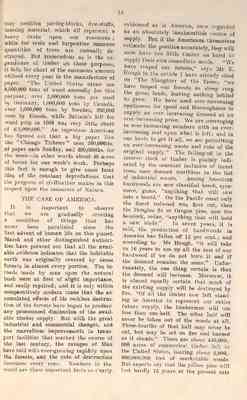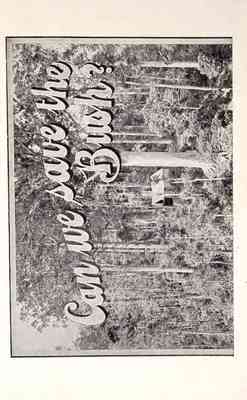Pages
This page is blank
15
may mention paving-blocks, dye-stuffs, tanning material, which all represent a heavy drain upong our resources ; while fro resin and turpentine immense quantitites of trees are unnually destroyed. But tremendous as is the expendigure of timber on these purposes, it falls far short of the enormous amount utilised every year in the manufacture of paper. "The United States along use 8,000,000 tons of wood annually for this purpose; over 2,000,000 tons are used by Germany, 1,000,000 tons by Canada, over 1,000,000 tons by Sweden, 200,000 tons by Russia, while Britain's bill for wood pulp in 1908 was very little short of £3,000,000." An ingenious American has figured out that a big paper like the "Chicago Tribune" uses 200,000lbs of paper each Sunday, and 400,000lbs. for the week--in other works about 40 acres of forest for one week's work. Perhaps this fact is enough to give some faint idea of the constant depredations that the progress of civilisation makes in this respect upon the resources of Nature.
THE CASE OF AMERICA.
It is important to observe that we are gradually creating a condition of things that has never been paralleled since the first advent of human life on this planet. Marsh and other distinguished authorities have pointed out that all the available evidence indicates that th eabitable earth was orgianlly covered by dense forests in almost every portion. The inroads made by man upon the natural bush were at first of slight importance, and easily repaired; and it is only within comparatively modern times that the accumulated effects of his reckless destruction of the forests have been to produce any pronounced diminution of the available timber supply. But with the great industrial and commercial changes, and the margellous improvements in transpost facilities that marked the coruse of the last century, the ravages of Man have toldw ith ever-growing rapidity upn the forests, and the rate of destruction increase every year. Nowhere in the world are these important facts so clearly evidenced as in America, once regarded as an absolutely inexhaustible source of supply. But if the Americans themselves estimate the position accurately, they will soon have too little timber on hand to supply their own immediate needs. "We have reaped our forests," says Mr E. Hough in the article I have already cited on "The Slaughter of the trees; "we have reaped our forests as sheep reap the grass lands, leaving nothing behind to grow. We ahve used ever-increasing appliances for speed and thoroughness to supply an every increasing demand at an ever-increasing price. We are converging in ever-increasing numbers wtih an everincreasing zeal upon what is left; and in our haste to get it all, we are permitting an ever-increasing waste and ruin of the original supply." The falling-off in the reserve stock of timber is plainly indicated by the constant inclusion of forest trees once deemed worthless in the list of indistrial wooks. Among American hardwoods are now classified beech, sycamore, gums, "anything that will saw into a board." On the Pacific coast only the finest redwood was first cut, then the Douglas fir or Oregon pine, now the hemlock, cedar, "anything that will hold a saw blade." In seven years, it is said, the production of hardwoods in America has fallen off 15 per cent.; and according to Mr Hough, "it will take us 16 years to use up all the rest of our hardwood if we do not burn it and if the demand remains the same." Unfortunately, the one thing certain is that the demand will increase. Moreover, it is almost equally certain that much of the existing supply will be destroyed by fire. "Of all the timber now left standing in America to represent our entrie future supply, the lumberman will use less than one-half. The other half will never be taken out of the woods at all. Three-fourths of that half may never be cut, but may be set on fire and burned as it stands." There are about 450,000,- 000 acres of commercial timber left in the United States, bearing about 2,000,- 000,000,000 feet of marketable woods. But expers say that the yellow pine will last hardly 15 years at the present rate
16
of consumption, and that the Douglas fir or Oregon pine will not stand more than 25 to 30 years of the present demand. In the whole United State more thank 100,000 acres of timber are cut over every working day; and taking into account the losses occasioned by fire, it is evident that unless something is done to retard the rate of consumption or to replenish the supply, America's stock of timber must soon near the point of absolute annihilation.
[Illustration]
Can we save the Bush?
This page is blank




